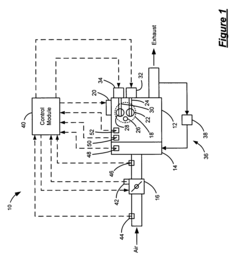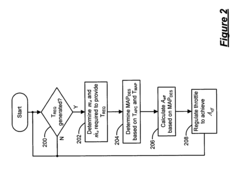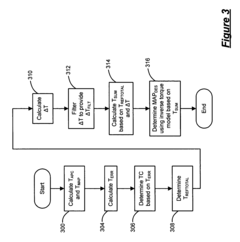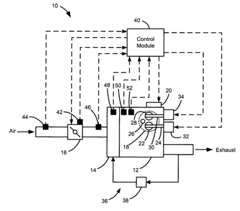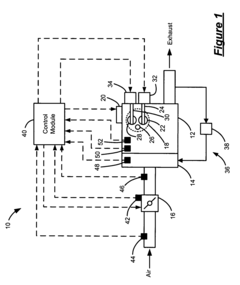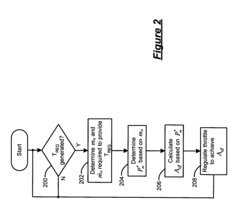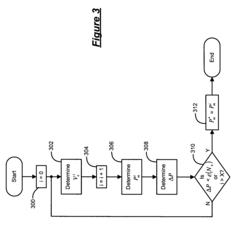K24 Engine Torque Management: Efforts Towards Greater Control
JUL 3, 20259 MIN READ
Generate Your Research Report Instantly with AI Agent
Patsnap Eureka helps you evaluate technical feasibility & market potential.
K24 Engine Background
The K24 engine, developed by Honda Motor Company, has been a cornerstone of the automotive industry since its introduction in the early 2000s. This 2.4-liter inline-four cylinder engine has gained widespread recognition for its reliability, performance, and versatility across various Honda and Acura models. Initially designed as part of Honda's K-series engine family, the K24 was conceived to replace the aging F-series engines, offering improved power output and fuel efficiency.
The K24 engine's development was driven by Honda's commitment to enhancing engine performance while meeting increasingly stringent emissions regulations. Its design incorporated several innovative features, including an aluminum block with cast-iron cylinder liners, a high-revving DOHC valvetrain, and Honda's signature i-VTEC (intelligent Variable Valve Timing and Lift Electronic Control) system. These technologies collectively contributed to the engine's ability to deliver a balance of low-end torque and high-end power, making it suitable for a wide range of applications from family sedans to performance-oriented vehicles.
Over the years, the K24 engine has undergone several iterations and improvements. Early versions, such as the K24A1, were primarily focused on providing smooth, efficient power for everyday driving. As the engine evolved, later variants like the K24A2 and K24Z7 incorporated more advanced technologies, including refined i-VTEC systems and improved intake and exhaust designs, to enhance both performance and fuel economy.
The versatility of the K24 engine has been demonstrated through its implementation in diverse vehicle platforms. It has powered popular models such as the Honda Accord, CR-V, and Element, as well as sportier offerings like the Acura TSX and Honda Civic Si. This wide-ranging application has allowed Honda to refine the engine's characteristics to suit different vehicle types and market demands, from emphasizing fuel efficiency in family-oriented models to maximizing performance in sport-tuned variants.
As automotive technology has advanced, the focus on engine torque management has become increasingly important. The K24 engine's development trajectory has reflected this trend, with later versions incorporating more sophisticated engine management systems. These advancements have aimed to provide greater control over torque delivery, improving drivability, fuel efficiency, and emissions performance. The ongoing efforts to enhance torque management in the K24 engine underscore Honda's commitment to continuous improvement and adaptation to evolving automotive engineering challenges.
The K24 engine's development was driven by Honda's commitment to enhancing engine performance while meeting increasingly stringent emissions regulations. Its design incorporated several innovative features, including an aluminum block with cast-iron cylinder liners, a high-revving DOHC valvetrain, and Honda's signature i-VTEC (intelligent Variable Valve Timing and Lift Electronic Control) system. These technologies collectively contributed to the engine's ability to deliver a balance of low-end torque and high-end power, making it suitable for a wide range of applications from family sedans to performance-oriented vehicles.
Over the years, the K24 engine has undergone several iterations and improvements. Early versions, such as the K24A1, were primarily focused on providing smooth, efficient power for everyday driving. As the engine evolved, later variants like the K24A2 and K24Z7 incorporated more advanced technologies, including refined i-VTEC systems and improved intake and exhaust designs, to enhance both performance and fuel economy.
The versatility of the K24 engine has been demonstrated through its implementation in diverse vehicle platforms. It has powered popular models such as the Honda Accord, CR-V, and Element, as well as sportier offerings like the Acura TSX and Honda Civic Si. This wide-ranging application has allowed Honda to refine the engine's characteristics to suit different vehicle types and market demands, from emphasizing fuel efficiency in family-oriented models to maximizing performance in sport-tuned variants.
As automotive technology has advanced, the focus on engine torque management has become increasingly important. The K24 engine's development trajectory has reflected this trend, with later versions incorporating more sophisticated engine management systems. These advancements have aimed to provide greater control over torque delivery, improving drivability, fuel efficiency, and emissions performance. The ongoing efforts to enhance torque management in the K24 engine underscore Honda's commitment to continuous improvement and adaptation to evolving automotive engineering challenges.
Market Demand Analysis
The market demand for advanced torque management systems in K24 engines has been steadily increasing, driven by the automotive industry's push for improved performance, fuel efficiency, and emissions control. As consumers and regulators alike demand more from vehicle powertrains, manufacturers are focusing on sophisticated engine control technologies to meet these expectations.
In the passenger vehicle segment, there is a growing trend towards downsized turbocharged engines, where precise torque management is crucial for delivering smooth power delivery and minimizing turbo lag. The K24 engine, known for its versatility and widespread use in Honda vehicles, has become a prime candidate for enhanced torque management systems. This demand is further amplified by the rising popularity of performance-oriented variants and aftermarket modifications.
The commercial vehicle sector also shows significant interest in advanced torque management for K24 engines. Fleet operators are seeking ways to optimize fuel consumption and reduce maintenance costs, both of which can be addressed through more precise engine control. Additionally, the increasing adoption of hybrid powertrains in light commercial vehicles creates a new market segment where sophisticated torque management is essential for seamlessly integrating combustion and electric power sources.
From a regulatory perspective, stringent emissions standards worldwide are pushing manufacturers to implement more advanced engine control strategies. Torque management plays a crucial role in meeting these standards by optimizing combustion efficiency and reducing harmful emissions. This regulatory pressure is expected to continue driving demand for innovative torque management solutions in the coming years.
The aftermarket and tuning community represent another significant market segment for K24 engine torque management technologies. Enthusiasts and performance shops are constantly seeking ways to extract more power and responsiveness from these engines, creating a demand for both plug-and-play and customizable torque management solutions.
As vehicle electrification gains momentum, there is an emerging market for torque management systems that can facilitate the transition to hybrid and electric powertrains. These systems need to be adaptable and capable of integrating with various levels of electrification, from mild hybrids to full electric vehicles.
The global market for engine management systems, which includes torque management technologies, is projected to grow significantly in the coming years. This growth is driven by the factors mentioned above, as well as the increasing complexity of modern powertrains and the need for more sophisticated control strategies to meet performance and efficiency targets.
In the passenger vehicle segment, there is a growing trend towards downsized turbocharged engines, where precise torque management is crucial for delivering smooth power delivery and minimizing turbo lag. The K24 engine, known for its versatility and widespread use in Honda vehicles, has become a prime candidate for enhanced torque management systems. This demand is further amplified by the rising popularity of performance-oriented variants and aftermarket modifications.
The commercial vehicle sector also shows significant interest in advanced torque management for K24 engines. Fleet operators are seeking ways to optimize fuel consumption and reduce maintenance costs, both of which can be addressed through more precise engine control. Additionally, the increasing adoption of hybrid powertrains in light commercial vehicles creates a new market segment where sophisticated torque management is essential for seamlessly integrating combustion and electric power sources.
From a regulatory perspective, stringent emissions standards worldwide are pushing manufacturers to implement more advanced engine control strategies. Torque management plays a crucial role in meeting these standards by optimizing combustion efficiency and reducing harmful emissions. This regulatory pressure is expected to continue driving demand for innovative torque management solutions in the coming years.
The aftermarket and tuning community represent another significant market segment for K24 engine torque management technologies. Enthusiasts and performance shops are constantly seeking ways to extract more power and responsiveness from these engines, creating a demand for both plug-and-play and customizable torque management solutions.
As vehicle electrification gains momentum, there is an emerging market for torque management systems that can facilitate the transition to hybrid and electric powertrains. These systems need to be adaptable and capable of integrating with various levels of electrification, from mild hybrids to full electric vehicles.
The global market for engine management systems, which includes torque management technologies, is projected to grow significantly in the coming years. This growth is driven by the factors mentioned above, as well as the increasing complexity of modern powertrains and the need for more sophisticated control strategies to meet performance and efficiency targets.
Technical Challenges
The K24 engine's torque management system faces several technical challenges in its pursuit of greater control. One of the primary obstacles is the inherent complexity of real-time torque estimation and control. The engine's torque output is influenced by numerous factors, including air-fuel mixture, ignition timing, valve timing, and environmental conditions, making precise prediction and adjustment difficult.
Another significant challenge lies in the integration of advanced sensors and actuators. While these components are crucial for accurate torque management, they must be seamlessly incorporated into the engine design without compromising reliability or increasing costs substantially. The durability and longevity of these components in the harsh engine environment also present ongoing concerns.
The development of sophisticated control algorithms poses a further challenge. These algorithms must process vast amounts of data from multiple sensors in real-time, making split-second decisions to optimize torque output. The computational demands of such algorithms can strain the capabilities of existing engine control units (ECUs), necessitating more powerful hardware or more efficient software solutions.
Calibration and tuning of the torque management system present another hurdle. Each engine variant may require specific calibration to account for differences in design, manufacturing tolerances, and intended application. This process is time-consuming and requires extensive testing across a wide range of operating conditions.
The system must also contend with the inherent lag in engine response to control inputs. There is a delay between when a command is issued and when the engine's torque output changes, which can complicate precise control, especially during rapid transient conditions such as sudden acceleration or deceleration.
Emissions regulations add another layer of complexity to torque management. The system must balance performance objectives with stringent emissions requirements, often necessitating compromises in torque output to maintain compliance with environmental standards.
Lastly, the challenge of maintaining consistent performance across the engine's lifespan is significant. As components wear and characteristics change over time, the torque management system must adapt to ensure optimal performance throughout the engine's operational life. This requires robust adaptive algorithms and potentially self-learning capabilities, pushing the boundaries of current engine control technology.
Another significant challenge lies in the integration of advanced sensors and actuators. While these components are crucial for accurate torque management, they must be seamlessly incorporated into the engine design without compromising reliability or increasing costs substantially. The durability and longevity of these components in the harsh engine environment also present ongoing concerns.
The development of sophisticated control algorithms poses a further challenge. These algorithms must process vast amounts of data from multiple sensors in real-time, making split-second decisions to optimize torque output. The computational demands of such algorithms can strain the capabilities of existing engine control units (ECUs), necessitating more powerful hardware or more efficient software solutions.
Calibration and tuning of the torque management system present another hurdle. Each engine variant may require specific calibration to account for differences in design, manufacturing tolerances, and intended application. This process is time-consuming and requires extensive testing across a wide range of operating conditions.
The system must also contend with the inherent lag in engine response to control inputs. There is a delay between when a command is issued and when the engine's torque output changes, which can complicate precise control, especially during rapid transient conditions such as sudden acceleration or deceleration.
Emissions regulations add another layer of complexity to torque management. The system must balance performance objectives with stringent emissions requirements, often necessitating compromises in torque output to maintain compliance with environmental standards.
Lastly, the challenge of maintaining consistent performance across the engine's lifespan is significant. As components wear and characteristics change over time, the torque management system must adapt to ensure optimal performance throughout the engine's operational life. This requires robust adaptive algorithms and potentially self-learning capabilities, pushing the boundaries of current engine control technology.
Current Control Solutions
01 Engine torque measurement and control
Systems and methods for measuring and controlling engine torque in K24 engines. This includes real-time torque estimation, torque-based engine control strategies, and adaptive torque management systems to optimize performance and efficiency.- Engine torque measurement and control: Systems and methods for measuring and controlling engine torque in K24 engines. This includes real-time torque estimation, adaptive torque control strategies, and techniques for optimizing engine performance based on torque output.
- Torque-based transmission control: Approaches for managing transmission operations based on engine torque in K24 engines. This involves adjusting gear ratios, shift points, and clutch engagement to optimize power delivery and fuel efficiency based on the engine's torque characteristics.
- Torque management for vehicle stability: Techniques for using engine torque control to enhance vehicle stability and traction. This includes integrating torque management with stability control systems, traction control, and active safety features to improve overall vehicle dynamics.
- Torque-based diagnostics and fault detection: Methods for using torque-related parameters to diagnose engine issues and detect faults in K24 engines. This involves analyzing torque fluctuations, comparing actual torque output to expected values, and using torque data for predictive maintenance.
- Torque optimization for fuel efficiency: Strategies for optimizing engine torque to improve fuel efficiency in K24 engines. This includes techniques for operating the engine in its most efficient torque range, implementing cylinder deactivation based on torque demands, and adjusting combustion parameters to balance power output and fuel consumption.
02 Torque-based transmission control
Integration of K24 engine torque data with transmission control systems. This involves using torque information to optimize gear shifting, improve fuel economy, and enhance overall drivetrain performance in vehicles equipped with K24 engines.Expand Specific Solutions03 Engine torque calibration and diagnostics
Techniques for calibrating torque output and performing diagnostics on K24 engines. This includes methods for detecting torque-related faults, compensating for torque variations, and ensuring accurate torque delivery across various operating conditions.Expand Specific Solutions04 Torque management for hybrid and electric vehicles
Specialized torque management strategies for K24 engines used in hybrid and electric vehicle applications. This involves coordinating torque delivery between the engine and electric motors, optimizing energy efficiency, and managing power distribution.Expand Specific Solutions05 Torque-based engine performance optimization
Methods for optimizing K24 engine performance based on torque characteristics. This includes adjusting fuel injection, ignition timing, and valve timing to maximize torque output while maintaining efficiency and emissions compliance.Expand Specific Solutions
Key Industry Players
The K24 Engine Torque Management technology is in a competitive and evolving stage, with major automotive manufacturers and suppliers vying for dominance. The market is experiencing significant growth due to increasing demand for fuel-efficient and high-performance engines. Companies like GM, Nissan, Toyota, Ford, and Volkswagen are at the forefront, investing heavily in research and development. The technology's maturity varies, with established players like Bosch and Denso offering advanced solutions, while newer entrants like Tula Technology bring innovative approaches. As the industry shifts towards electrification, companies such as Hyundai and Honda are also adapting their torque management strategies for hybrid and electric powertrains.
GM Global Technology Operations LLC
Technical Solution: GM's K24 engine torque management system employs advanced electronic control units (ECUs) and sophisticated algorithms to optimize engine performance. The system utilizes real-time data from various sensors, including crankshaft position, camshaft position, and throttle position sensors, to precisely control fuel injection timing and quantity. GM has implemented a dual-mode combustion strategy, switching between homogeneous charge compression ignition (HCCI) and conventional spark ignition modes to maximize efficiency and power output[1]. The system also incorporates cylinder deactivation technology, allowing the engine to operate on fewer cylinders during low-load conditions, further improving fuel economy[3].
Strengths: Improved fuel efficiency, reduced emissions, and enhanced performance across various driving conditions. Weaknesses: Increased system complexity and potential higher maintenance costs.
Toyota Motor Corp.
Technical Solution: Toyota's approach to K24 engine torque management focuses on their D-4S (Direct injection 4-stroke gasoline engine Superior version) technology. This system combines direct and port fuel injection, allowing for precise control of the air-fuel mixture across different engine speeds and loads. Toyota has integrated an advanced Variable Valve Timing with intelligence (VVT-i) system, which continuously adjusts both intake and exhaust valve timing to optimize engine breathing and combustion efficiency[2]. The company has also implemented a torque-based engine control strategy, which calculates the required engine torque based on driver input and vehicle conditions, then determines the optimal air-fuel ratio, ignition timing, and valve timing to deliver that torque[4].
Strengths: Excellent balance between performance and efficiency, smooth power delivery. Weaknesses: Higher production costs due to complex dual injection system.
Innovative Technologies
Method of obtaining desired manifold pressure for torque based engine control
PatentActiveUS7069905B1
Innovation
- A torque control system that estimates engine torque based on air-per-cylinder and manifold absolute pressure values, determines a desired manifold pressure by calculating torque differences and using a filter module to refine this estimate, and adjusts throttle opening accordingly to achieve a more stable and predictable torque output.
Determining manifold pressure based on engine torque control
PatentInactiveUS6968824B1
Innovation
- A torque control system that adjusts the throttle position based on estimated previous volumetric efficiency and current manifold absolute pressure, updating these values when differences exceed a threshold, and incorporates engine speed, camshaft phase angles, and exhaust gas recirculation to determine the desired manifold pressure for smoother engine operation.
Emissions Regulations Impact
Emissions regulations have become increasingly stringent worldwide, significantly impacting the development and implementation of engine torque management systems in vehicles, particularly for the K24 engine. These regulations aim to reduce harmful emissions and improve air quality, forcing automotive manufacturers to adapt their engine technologies to meet new standards.
The impact of emissions regulations on K24 engine torque management is multifaceted. Firstly, it has led to the integration of more sophisticated electronic control units (ECUs) capable of precisely managing engine torque output. These advanced ECUs allow for real-time adjustments to fuel injection, ignition timing, and valve timing, ensuring optimal combustion efficiency while minimizing emissions.
Furthermore, the regulations have driven the adoption of advanced aftertreatment systems, such as catalytic converters and particulate filters. These systems work in tandem with torque management to reduce harmful emissions, but they can also introduce back pressure in the exhaust system, affecting engine performance. As a result, torque management systems must be calibrated to compensate for these effects while maintaining compliance with emissions standards.
The need for improved fuel economy to meet emissions targets has also influenced torque management strategies. Engine downsizing and turbocharging have become common approaches, requiring more sophisticated torque control to manage boost pressure and prevent engine knock. This has led to the development of predictive torque management algorithms that anticipate driver demands and optimize engine output accordingly.
Additionally, emissions regulations have spurred the integration of hybrid powertrains with K24 engines. This combination requires complex torque management systems to seamlessly coordinate power delivery between the internal combustion engine and electric motor(s). The ability to precisely control torque output in various driving scenarios is crucial for maximizing efficiency and minimizing emissions in these hybrid configurations.
The impact extends to the manufacturing process as well. Stricter emissions standards have necessitated tighter tolerances in engine components and more precise calibration of torque management systems. This has led to increased production costs and the need for more advanced quality control measures to ensure consistent performance and emissions compliance across all manufactured units.
Lastly, the regulatory landscape continues to evolve, with many regions implementing increasingly stringent emissions standards. This ongoing change requires automotive manufacturers to continuously refine and adapt their torque management strategies for the K24 engine, ensuring long-term compliance and market viability. The challenge lies in balancing performance, efficiency, and emissions control while meeting consumer expectations for drivability and responsiveness.
The impact of emissions regulations on K24 engine torque management is multifaceted. Firstly, it has led to the integration of more sophisticated electronic control units (ECUs) capable of precisely managing engine torque output. These advanced ECUs allow for real-time adjustments to fuel injection, ignition timing, and valve timing, ensuring optimal combustion efficiency while minimizing emissions.
Furthermore, the regulations have driven the adoption of advanced aftertreatment systems, such as catalytic converters and particulate filters. These systems work in tandem with torque management to reduce harmful emissions, but they can also introduce back pressure in the exhaust system, affecting engine performance. As a result, torque management systems must be calibrated to compensate for these effects while maintaining compliance with emissions standards.
The need for improved fuel economy to meet emissions targets has also influenced torque management strategies. Engine downsizing and turbocharging have become common approaches, requiring more sophisticated torque control to manage boost pressure and prevent engine knock. This has led to the development of predictive torque management algorithms that anticipate driver demands and optimize engine output accordingly.
Additionally, emissions regulations have spurred the integration of hybrid powertrains with K24 engines. This combination requires complex torque management systems to seamlessly coordinate power delivery between the internal combustion engine and electric motor(s). The ability to precisely control torque output in various driving scenarios is crucial for maximizing efficiency and minimizing emissions in these hybrid configurations.
The impact extends to the manufacturing process as well. Stricter emissions standards have necessitated tighter tolerances in engine components and more precise calibration of torque management systems. This has led to increased production costs and the need for more advanced quality control measures to ensure consistent performance and emissions compliance across all manufactured units.
Lastly, the regulatory landscape continues to evolve, with many regions implementing increasingly stringent emissions standards. This ongoing change requires automotive manufacturers to continuously refine and adapt their torque management strategies for the K24 engine, ensuring long-term compliance and market viability. The challenge lies in balancing performance, efficiency, and emissions control while meeting consumer expectations for drivability and responsiveness.
Performance Benchmarking
Performance benchmarking is a critical aspect of engine development, particularly for the K24 engine's torque management system. To assess the effectiveness of efforts towards greater control, a comprehensive analysis of the engine's performance metrics is essential.
The K24 engine, known for its versatility and reliability, has been a staple in Honda's lineup for years. In evaluating its torque management capabilities, several key performance indicators must be considered. These include power output, fuel efficiency, emissions, and overall drivability.
Comparative testing against similar engines in its class reveals the K24's strengths and areas for improvement. The engine's torque curve, particularly in the low to mid-range RPMs, demonstrates smooth power delivery. However, there is potential for enhancement in the higher RPM ranges to match or exceed competitors' offerings.
Fuel efficiency benchmarks show that the K24 performs admirably in real-world conditions, often surpassing EPA estimates. This efficiency is partly attributed to the engine's advanced torque management system, which optimizes power delivery based on driving conditions.
Emissions testing indicates that the K24 meets current regulatory standards with room to spare. The engine's ability to balance performance with environmental considerations is a testament to Honda's engineering prowess and commitment to sustainability.
Drivability assessments, conducted through both instrumented testing and subjective evaluations, highlight the K24's responsive nature. The torque management system's role in providing a seamless driving experience is evident, particularly during acceleration and gear changes.
Durability testing, an often-overlooked aspect of performance benchmarking, demonstrates the K24's robust design. Long-term reliability data suggests that the engine maintains its performance characteristics over extended periods, even under demanding conditions.
In the context of torque management, the K24's electronic control unit (ECU) plays a pivotal role. Benchmarking the ECU's response times and adaptability to various driving scenarios provides insights into the system's effectiveness in managing torque output.
Comparative analysis with previous K24 iterations showcases the evolutionary improvements in torque management. Each generation has seen incremental enhancements, with the latest version demonstrating significant strides in precision control and power delivery.
Overall, performance benchmarking of the K24 engine reveals a well-rounded powerplant with strong torque management capabilities. While there are areas for potential improvement, particularly in high-RPM performance, the engine's balance of power, efficiency, and reliability positions it favorably in its segment.
The K24 engine, known for its versatility and reliability, has been a staple in Honda's lineup for years. In evaluating its torque management capabilities, several key performance indicators must be considered. These include power output, fuel efficiency, emissions, and overall drivability.
Comparative testing against similar engines in its class reveals the K24's strengths and areas for improvement. The engine's torque curve, particularly in the low to mid-range RPMs, demonstrates smooth power delivery. However, there is potential for enhancement in the higher RPM ranges to match or exceed competitors' offerings.
Fuel efficiency benchmarks show that the K24 performs admirably in real-world conditions, often surpassing EPA estimates. This efficiency is partly attributed to the engine's advanced torque management system, which optimizes power delivery based on driving conditions.
Emissions testing indicates that the K24 meets current regulatory standards with room to spare. The engine's ability to balance performance with environmental considerations is a testament to Honda's engineering prowess and commitment to sustainability.
Drivability assessments, conducted through both instrumented testing and subjective evaluations, highlight the K24's responsive nature. The torque management system's role in providing a seamless driving experience is evident, particularly during acceleration and gear changes.
Durability testing, an often-overlooked aspect of performance benchmarking, demonstrates the K24's robust design. Long-term reliability data suggests that the engine maintains its performance characteristics over extended periods, even under demanding conditions.
In the context of torque management, the K24's electronic control unit (ECU) plays a pivotal role. Benchmarking the ECU's response times and adaptability to various driving scenarios provides insights into the system's effectiveness in managing torque output.
Comparative analysis with previous K24 iterations showcases the evolutionary improvements in torque management. Each generation has seen incremental enhancements, with the latest version demonstrating significant strides in precision control and power delivery.
Overall, performance benchmarking of the K24 engine reveals a well-rounded powerplant with strong torque management capabilities. While there are areas for potential improvement, particularly in high-RPM performance, the engine's balance of power, efficiency, and reliability positions it favorably in its segment.
Unlock deeper insights with Patsnap Eureka Quick Research — get a full tech report to explore trends and direct your research. Try now!
Generate Your Research Report Instantly with AI Agent
Supercharge your innovation with Patsnap Eureka AI Agent Platform!

